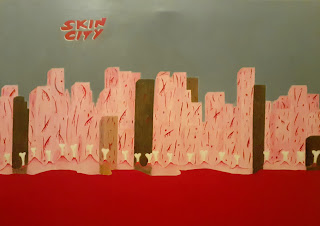'Do Humans Create Society, or Does Society Create Humans' ('lEGG' artwork)
The question of whether humans create society or society creates humans has sparked debate among philosophers, sociologists, and anthropologists for centuries. It forces us to examine the relationship between individual agency and structural influence—a relationship that ultimately shapes human experience, behavior, and history.
From one perspective, society is a construct—a deliberate creation by human beings seeking order, cooperation, and survival. Enlightenment thinkers such as John Locke and Jean-Jacques Rousseauproposed that individuals formed societies through social contracts. According to this view, humans are autonomous agents who unite to form institutions, laws, and cultural norms.
Everything from democratic governments to family structures can be seen as human inventions. Language, religion, economics, and art are all expressions of the human desire to connect and create. As such, society becomes an extension of collective human will, shaped over time by decisions, values, and innovations.
“Man is born free, and everywhere he is in chains.”
– Jean-Jacques Rousseau, The Social Contract (1762)
This quote reflects the idea that while individuals may create society, they often become bound by its constructs. It highlights the tension between freedom and order in the process of social formation.
On the other side of the argument, society is seen as the force that shapes individuals. The moment we are born, we are immersed in a web of language, beliefs, roles, and expectations that mold our identity. According to Émile Durkheim, society is a “social fact”—something external to the individual, yet exerting control over them.
Durkheim argued that our morals, customs, and even emotions are largely influenced by the social environment. Similarly, George Herbert Mead’s concept of the “social self” suggests that our identity is formed through interaction with others, not in isolation.
“The individual experiences himself as such not directly, but only indirectly, from the particular standpoint of the social group.”
– George Herbert Mead, Mind, Self, and Society (1934)
In this view, society acts as a mirror—reflecting back what we should be, think, and do.
Rather than choosing one side, many scholars now emphasize the reciprocal relationship between humans and society. Humans create society, yes—but once created, society influences, constrains, and reproduces human behavior. It is a continuous feedback loop in which individual agency and social structure co-exist and co-evolve.
Sociologist Anthony Giddens describes this dynamic in his theory of structuration, where human actions both shape and are shaped by social structures (Giddens, 1984). Institutions, cultures, and norms are maintained only because individuals continue to act within them. But those same structures limit what seems possible or acceptable.
This circular process means that we are both products and producers of society.
So, do humans create society, or does society create humans? The answer is both. Humans shape society through intention and action, but they do so within frameworks passed down by previous generations. Society, in turn, shapes humans through socialization, education, and cultural conditioning.
Recognizing this mutual relationship gives us power—and responsibility. It reminds us that while we are influenced by the world around us, we also have the capacity to question, challenge, and reshape it.
Finally, my work explores the timeless and reciprocal question:
Do humans create society, or does society create humans?
This body of art is an investigation into the complex, ever-shifting relationship between the individual and the structures that surround us. Are we the architects of culture and civilization—or are we, ourselves, the blueprints drawn by systems we inherit?
Through layered symbolism, mixed media elements, and contrasting forms, I seek to visualize this tension. The human figure often appears both as creator and creation—shaping and shaped—standing at the intersection of freedom and conditioning. Textures and colors are intentionally used to distinguish moments of agency from moments of influence. Hard lines and grids represent structure, order, and societal constructs, while fluid strokes and organic forms represent the unpredictable force of human will and expression.
This work does not attempt to provide a final answer. Instead, it asks the viewer to confront their own position within this ongoing loop. How much of what we believe, desire, or fear is truly our—and how much is a reflection of the world that raised us?
Do humans build the walls of time,
with hands that shape, with minds that climb?
Do we sketch the lines of law and lore,
and lay the roads we've walked before?
Or is it not our breath, but borrowed air,
that whispers who we are, from where?
Does society craft the skin we wear,
teach us how to love, to lie, to care?
We hammer the tools, we raise the stone,
but do we build, or just atone?
For patterns passed from womb to grave,
for silent rules we learn to crave.
A child is born with open eyes,
but soon is taught the cost of cries—
what games to play, what dreams to hide,
what parts to show, what truths to bide.
Is freedom forged, or softly given?
Are we the authors, or the written?









